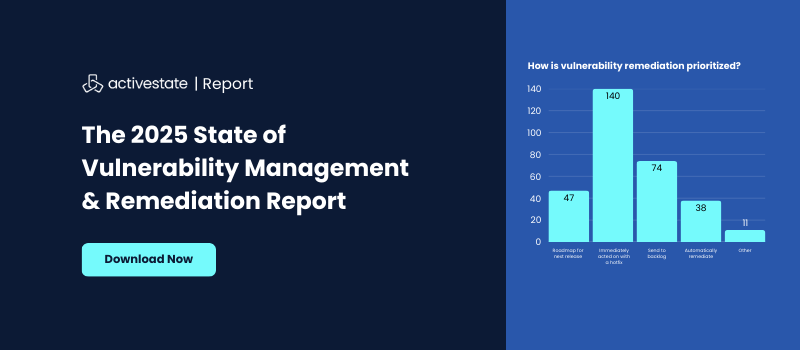Open source software (OSS) has become the backbone of modern applications, with many organizations using it in some capacity. While OSS offers many benefits like faster development and innovation, it also introduces security complexities that can leave your applications vulnerable. The need for robust security measures has never been greater, and that’s where Application Security Posture Management (ASPM) comes into play.
ActiveState’s new whitepaper, “ASPM: The Invisible Shield for your Open Source Ecosystem,” dives into the critical role ASPM plays in securing your open source journey. It explores the challenges of managing OSS at scale and provides actionable insights into how ASPM can help you mitigate vulnerabilities and unlock the full potential of open source.
Why ASPM Matters
Organizations are building applications faster than ever. With the rise of AI and low-code platforms, the global custom software development market is booming, expected to reach $35.42 billion in 2023 and grow at a CAGR of 22.5% between 2024 and 2030. However, this rapid pace of development can also introduce security risks if not managed properly.
The whitepaper defines ASPM as a solution that provides a single, overall view of an application’s security status. It consolidates information from various development-oriented testing tools, as well as cloud or infrastructure security issues to create a comprehensive security posture. This is critical because a vulnerability in one open source component can expose an entire application to data breaches, financial losses, and reputational damage.
ASPM vs. Other Security Tools
It’s important to understand how ASPM differs from other security tools. The whitepaper provides a useful comparison:
- ASPM vs. SAST/DAST/SCA: While tools like Static Application Security Testing (SAST), Dynamic Application Security Testing (DAST), and Software Composition Analysis (SCA) focus on specific aspects of the software development lifecycle (SDLC), ASPM offers a holistic view. ASPM provides a unified approach, bringing together the insights of other tools to improve visibility into an application’s security.
- ASPM vs. CSPM: Cloud Security Posture Management (CSPM) focuses on securing cloud-based infrastructure, while ASPM is concerned with the security of each application and all of its connections.
- ASPM vs. DIY: Building your own security toolkit using various open source tools can be costly and time-consuming in terms of development and maintenance. An ASPM tool provides a single workstream and support.
Six Practical Uses of ASPM for Your Open Source Journey
The whitepaper highlights six practical use cases for ASPM in your open source strategy, which are described in more detail:
- Discoverability and Observability: ASPM automatically scans your environment to identify all direct and transitive OSS dependencies, providing a real-time inventory of your entire open source footprint.
- Continuous Open Source Integration: ASPM ensures secure and efficient integration of open source components into your development workflow.
- Secure Environment Management: ASPM helps maintain consistent and reproducible development, testing, and production environments.
- Governance & Policy Management: You can use ASPM to define and enforce rules around open source licenses, risk levels, and approved sources.
- Regulatory Compliance: ASPM ensures your organization complies with government regulations.
- Beyond End-of-Life Support: ASPM proactively identifies and mitigates risks associated with end-of-life (EOL) open source components.
ActiveState’s ASPM Solution
ActiveState’s ASPM platform provides a comprehensive solution for managing open source security. It goes beyond just identifying vulnerabilities by offering intelligent remediation and deployment, automatically rebuilding code from the source and seamlessly integrating with your CI/CD system. Key features of the ActiveState platform include:
- Comprehensive View of Security Health: ASPM provides a continuous view of security across development, testing, deployment, and production stages.
- Hardened Build System: ActiveState allows you to leverage a customizable build infrastructure.
- Intelligent Remediation and Deployment: ActiveState automates remediation, rebuilding code directly from the source and integrates with CI/CD systems to deploy the fix quickly.
- Frictionless and Scalable Integration: The platform integrates with your existing workflows and developer tools, compatible with any open source language or ecosystem.
- Centralized Platform: The ActiveState platform provides a centralized platform for governance and policy management and allows you to define and enforce rules around acceptable open-source licenses, acceptable risk levels for vulnerabilities, and approved sources for OSS components.
- Empirical Observability: The platform lets you visualize what open source is being used, where it’s deployed, and where it came from.
- Scalable Consistency: You can centrally manage and reproduce environments across teams and infrastructure.
Shift Left With ASPM
The whitepaper emphasizes the need for DevSecOps teams to implement security earlier in the development process. ASPM empowers organizations to “shift left” by integrating security into the beginning of the development lifecycle. This proactive approach to security helps to accelerate productivity while protecting the business from potential attacks.
Get Your Copy of the Whitepaper
Ready to gain full visibility and control over your software supply chain? Download “ASPM: The Invisible Shield for your Open Source Ecosystem” today and discover how ActiveState can help you secure your open source journey and achieve true intelligent remediation.
By implementing a robust ASPM solution, organizations can confidently leverage the power of open source while protecting themselves from the risks.







